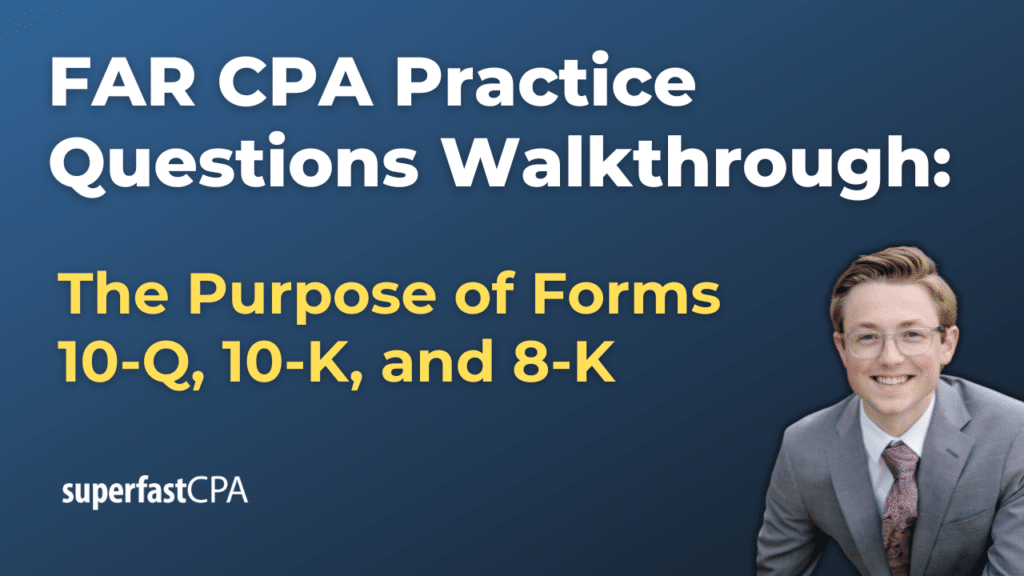In this video, we walk through 5 FAR practice questions teaching about understanding the purpose of forms 10-Q, 10-K, and 8-K. These questions are from FAR content area 1 on the AICPA CPA exam blueprints: Financial Reporting.
The best way to use this video is to pause each time we get to a new question in the video, and then make your own attempt at the question before watching us go through it.
Also be sure to watch one of our free webinars on the 6 “key ingredients” to an extremely effective & efficient CPA study process here…
The Purpose of Forms 10-Q, 10-K, and 8-K
In the world of public companies, it’s important to understand the purpose of forms 10-Q, 10-K, and 8-K. Staying transparent with shareholders and regulatory bodies is key. To ensure that, the Securities and Exchange Commission (SEC) requires public companies to submit various reports that provide insights into their financial health, significant events, and overall operations. The most common forms are the 10-Q, 10-K, and 8-K, each serving a unique purpose and following strict filing deadlines.
Form 10-Q: The Quarterly Financial Snapshot
Purpose:
The Form 10-Q is a quarterly report that gives investors a continuous view of a company’s financial position. Companies file this form three times a year, covering each of the first three quarters. In the fourth quarter, companies file the more comprehensive 10-K instead. The 10-Q provides unaudited financial statements and helps investors monitor the company’s performance on a regular basis. This form includes important details about the company’s liquidity, capital resources, and operational updates.
Filing Deadlines:
- Large Accelerated and Accelerated Filers: Must file within 40 days after the end of each quarter.
- Non-Accelerated Filers: Have an extra 5 days, with a filing deadline of 45 days after the end of the quarter.
Form 10-K: The Annual Financial Overview
Purpose:
The Form 10-K is the more detailed annual report that provides a full, audited financial picture of the company. It covers a company’s fiscal year and includes everything from detailed financial statements to a management discussion and analysis (MD&A) that looks at the company’s performance and future outlook. This report also covers information on market risks, products or services, and the company’s operations.
Filing Deadlines:
- Large Accelerated Filers: Must file within 60 days after the end of the fiscal year.
- Accelerated Filers: Have a slightly longer deadline of 75 days.
- Non-Accelerated Filers: Have the most time, with 90 days to file after the fiscal year ends.
This distinction in filing times is designed to accommodate smaller companies (non-accelerated filers) and give them more time compared to their larger counterparts.
Form 8-K: Reporting Significant Events
Purpose:
While the 10-Q and 10-K provide periodic financial updates, the Form 8-K is designed to notify shareholders of significant events that occur between these regular filings. Companies must file an 8-K whenever a material event happens that could impact investors’ decisions. These events can include anything from executive changes, acquisitions, and mergers to changes in auditors or financial restatements. The key here is that these events are often time-sensitive, and the 8-K provides a way to quickly disclose them.
Filing Deadline:
- All companies, regardless of size, must file an 8-K within 4 business days of the triggering event.
Understanding Filer Classifications
To better understand filing deadlines, it’s important to know the SEC’s filer classifications:
- Large Accelerated Filers: Public companies with a public float of $700,000,000 or more.
- Accelerated Filers: Companies with a public float between $75,000,000 and $700,000,000.
- Non-Accelerated Filers: Companies with a public float of less than $75,000,000 or those meeting other size-based criteria, such as annual revenues under $100,000,000.
These classifications help determine the amount of time a company has to file its 10-Q and 10-K forms, with larger companies (large accelerated filers) expected to meet shorter deadlines due to their greater resources.













